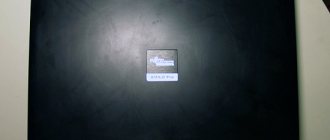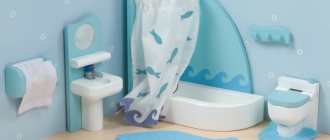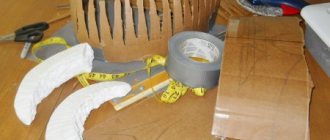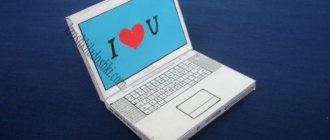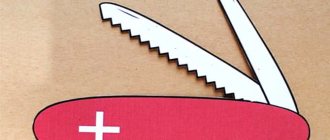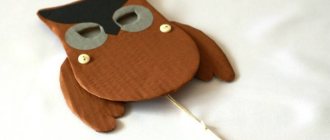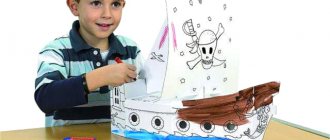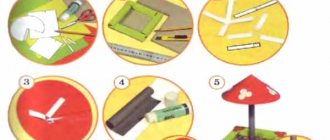If you don't know how to entertain your children, offer them a laptop. Just not the one on which you become dependent, your eyesight becomes blurred and your nerves fray. Make your own modern gadget out of cardboard. This toy is suitable even for the little ones; they will happily play with it for hours. Here's how to make such a thing according to the instructions in a few simple steps.
Materials and tools:
- a large piece of cardboard;
- stationery knife;
- ruler;
- black chalk paint;
- chalk;
- brush;
- electrical insulating tape;
- glue;
- pen;
- black thick paper (optional, for decoration).
Paper computer
Why make a paper model of a computer?
There can be many options - a simple toy for a child, an accessory for his doll, a postcard for an adult lover of high technology, or a comic gift. Only the size changes, and the basic step-by-step instructions on how to make a notebook out of paper are the same for all crafts. It is not difficult to guess that the doll and the child himself need computers of different sizes. If you are making a card as a gift, choose an arbitrary perimeter of the blank. An interesting idea is to make a model of a laptop and give it as a gift in a box from a real PC. Just keep in mind that such a gift should only be given to a person with a good sense of humor. If you have doubts about the recipient's reaction, abandon the idea.
How to make a laptop out of paper with your own hands?
You will need two sheets of paper or cardboard of equal size. We connect the base and lid using tape or thread. We have the preparation. Now is the time to start decorating it. The keyboard can be drawn or glued from individual paper “buttons”. We make the display in the same way. We draw it on the inside of the lid or glue it. A paper laptop can display a search engine page, desktop, or the gift recipient's favorite website. You can make the screen replaceable. To do this, glue narrow strips to frame it. The top piece of paper or cardboard needs to be secured only at the edges, leaving a hole through which new images can be inserted.
Ideas for decorating a paper notebook
You can use an empty candy box with a lift-off lid as the base for this craft. Another interesting idea is to make a voluminous notebook out of paper with your own hands. To do this, for the side edges you will need rectangles made of the same material as the base. Bend each rectangle twice and glue it to the base. You should also leave a free strip of paper where the lid bends to ensure an even closure of the product. This design allows you to create three-dimensional buttons. Use paper cubes that are easy to fold yourself. You can also take spare parts from an old real keyboard. Don’t forget to decorate the outside of the lid with the manufacturer’s “label.”
Tips and tricks to follow
Themed lapbooks are a great way to save money on toy purchases.
Often, after watching cartoons, children ask their parents to buy various products with the image of the character they like. Requests are repeated after each new video. Instead of buying toys, you can make a themed lapbook with the story of your favorite character. It will also be an excellent educational tool.
The product can be for school subjects. A laptop is a great way to learn new information and consolidate old information. This is a way to get to know an unloved subject better and change your attitude towards it.
Instead of colored paper, the base of the product can be covered with felt. Then the parts can be attached to it with miniature Velcro.
If you wish, you can make a lapbook with your own hands quickly and easily. At the same time, you can either repeat existing ideas using other people’s layouts, or create a unique book/box personally for your child.
Toy children's laptop made of paper | Radish
Toy paper laptop with interchangeable screens (4 pcs).
The laptop is quite compact (A4 format - this is when unfolded). The keyboard is small, but all the buttons are located the same as on the real one.
Your child will be able to look at photographs, choose a car or an exercise bike for their home, and observe the dynamics of prices on the world market - thanks to interchangeable screens.
Click on the desired image to download it. Detailed download instructions can be found in the FAQ section.
Print the outside and inside of the laptop on separate sheets of paper. Make cuts along the dotted line along the edges of the screen.
Then glue the sides of the laptop together so that the space behind those dotted lines at the edges of the monitor is left empty (so that another image can be inserted and secured).
For rigidity, one of the sides can be glued to cardboard.
2. Notebook images.
Download and print screens for a children's laptop (4 options on 2 A4 sheets).
Print and cut out the screens. The images are mounted on top of the monitor using side “holders” that need to be inserted into the slots on the sides of the monitor.
You can also make your own versions of images for your child.
—A toy laptop made of paper. Print notebook. Children's laptop for games. Laptop with changeable images on the screen.
CARDIAC - DIY paper computer / Sudo Null IT News
And recently I came across a description of a computer model made of paper, developed in 1968 at Bell Labs. The computer is called CARDIAC (CARDboard Illustrative Aid to Computation), which roughly translates to Cardboard Visual Aid to Computation. That is, in fact, it is not really a computer, since a person acts as a conductor of signals, as well as an arithmetic-logical device in it. However, it does provide insight into some of the principles underlying modern computing. In addition, after a short search, I found a description and materials for making CARDIAC.
CARDIAC consists of two blocks - memory and processor. Several paper strips are inserted into the processor unit with the help of which you need to select the instruction to be executed. In addition, a tape with output data is inserted into the memory block, and a tape with input data is inserted into the processor.
This is what the original memory block looks like:
Paper computer
Signals in the car are transmitted using the piston principle. When the block is shifted by one unit of length, a positive value is transmitted, otherwise zero. NOT AND OR XOR RS flip-flop Decoder Delay line The delay line is controlled by the machine operator using the appropriate lever. When you need to continue the signal, the red light comes on, otherwise the green light comes on. The delay line can be used to continue the signal over long distances if the paper power is not enough. Pulse generator Demonstration machine with basic logic gates I would really like to hear the opinions and advice of experts regarding this project and the chances of creating a full-fledged paper computer. I will be happy to answer any of your questions.
Thank you for your attention!
- paper
- cardboard
- paper model
- logic gates
- computer
Making a personal computer for a child with your own hands
Well, what child doesn’t dream of his own laptop, like his mom and dad? All children want to have access to a personal computer, but we parents don't like to let them near it because it's not very useful. Children have no use for real computers; they only damage their eyesight. But why not make the kids their own little laptops? Make them together and the children will be happy! This craft will be very interesting for them.
To make a laptop that will even fold and unfold, just like a real one, you will need:
- large piece of thick cardboard
- scissors
- black paint with a chalkboard effect (you can use this paint with crayons, but if you couldn’t find such paint, you can also use gouache)
- tassel
- crayons
- ruler
- pencil
First, measure out a piece of cardboard from which the laptop base will be made. Cut out this part. Then mark the center so you can bend the laptop. Cut a little with a stationery knife to make it easier to fold. You can do it another way: completely cut this piece of cardboard into two parts, and then join it with adhesive tape so that these parts also bend freely.
Now cut out three more small parts from cardboard: for the keyboard, screen and mouse. Even smaller parts will be needed for individual keys. Cover these parts with black red and let dry. Later we glue all this to the main part of the laptop.
Now we begin to decorate the laptop. For example, you can make a name plate with the child's name.
The computer is ready. Now your child will be able to carry it with him everywhere, and also write something new with crayons every day (provided that you used chalkboard-effect paint).
Based on materials from the site: https://www.handmadecharlotte.com/
Lapbook. Lapbooks on all topics - A laptop is an indispensable thing for a teacher
Publication “Lapbook is an indispensable thing for...”
A laptop is an indispensable thing for a teacher Author: Khabibullina A.D. A laptop is a very interesting multifunctional manual that has become extremely popular among parents of preschoolers and schoolchildren, teachers, and even among children themselves. Moreover, its popularity is growing all the time...
Image library "MAAM-pictures"
Using the “Fun Counting” lapbook in developing mathematical abilities in preschool children
“Mathematics is the queen of sciences, and arithmetic is the queen of mathematics” - these are the words of the famous German mathematician Carl Gauss. In our work, we will characterize the preparation of children of senior preschool age for familiarization with arithmetic operations, which is necessary for further mastery...
Lapbook for children 5–7 years old “I love mathematics” Designed for children 5–7 years old. Goal: this is the mastery of children in mathematical ways of cognition using educational games. Layout components: 1 element: Name of the laptop. 2nd element: 1 pocket “Fun problems in verses”, 2 pockets “Math palette” 3rd element: 1 pocket...
Lapbook as a means of introducing preschool children to the world of professions
In connection with the implementation of the Federal State Educational Standard for Education, each teacher is looking for new approaches, ideas, forms and methods in his teaching activities that would be interesting to preschoolers and would be appropriate for their age, and would most effectively solve pedagogical, educational and educational issues...
Master class: how to make a toy computer from cardboard
Materials and tools:
— sheets of A4 size office paper (for printing templates); — packaging corrugated cardboard (3 mm thick); - standard (stationery) knife; - metal ruler; - scissors; - double sided tape; - masking tape; - pencil and/or compass; — glue “Moment Crystal”; - glue stick; - a piece of whatman paper.
And, as usual, you will need templates. You can download them here:
Now we will make a stationary version of the computer, the main element of which is the monitor. Its dimensions are as follows: 40x26.5 cm - external dimensions of the screen, 33 cm - height.
We start production in the traditional way - first we print out part templates on office paper.
Using a glue stick, glue the halves of templates E-1 and E-2 , aligning them along the red line.
We cut out all the templates with small allowances.
STAND
To speed up the process, you can cut out parts 2 pieces at a time by folding the cardboard into 2 layers. But if it is too difficult, you can cut it in 1 layer, but in this case you will need to print more templates.
So, we fold 2 suitable pieces of corrugated cardboard with their right sides facing each other and fasten them at the edges with pieces of masking tape. Using pieces of double-sided tape, we attach a template of parts P-1 and P-2 , placing it in accordance with the recommended direction of the waves of the corrugated layer of cardboard (i.e., parallel to the lines visible on the wrong side of the cardboard).
Using a stationery knife, cut out the parts along the outer contour.
Advice! Don't try to cut right through. First, use short pressing movements to walk the knife along the contour, then with long movements, rotating the cardboard, walk in a circle several times until it is completely cut through.
After this, we separate one round part and cut out slots in the second part.
P-2 parts (they are larger in diameter) with slots using the following template. Then we transfer the template to a new piece of cardboard and cut out one piece P-3 (smaller diameter), also with slots.
We glue all the parts of the stand with Moment Crystal glue, as shown in the photo. It is advisable to combine the pattern of cuts of all the parts - this way the stand will look better.
RACK
We cut out the parts: S-1 - 1 piece, S-2 - 4 pieces, S-3 - 8 pieces.
For part C-1, only cuts need to be made along the blue lines, without cutting through the very bottom layer (i.e., the front layer of cardboard). Then peel off 2 layers of cardboard in areas around the edges and in the center of the piece.
Glue parts C-2 to part C-1 , as shown in the photo.
Let me note right away: single-layer sections are made so that the stand is almost completely wrapped in an outer layer of cardboard. But you don’t have to do this, just cut out 2 additional parts C-2 instead of C-1 . Choose the option that you like best.
We glue all the parts of S-3 .
And glue the workpiece to parts C-1 + C-2 .
We apply glue to part C-3 , as well as to the central single-layer section of part C-1 . We glue the workpiece.
Glue the remaining single-layer sections.
The stand for the toy monitor is ready.
SCREEN
Part E-1 is cut along the outer contour of the composite template. It is necessary to cut out 4 such parts. To do this, you can cut out the template exactly along the outer contour and then trace it on cardboard with a pencil.
Or you can use the point of a compass to mark the corners of the part. Then you can cut the sides of the parts using a ruler between these points. Rounded areas of parts can be indicated by several points placed along an arc.
Part E-2 is a frame. It must be cut out in one copy.
Remember to position the templates according to the recommended wave direction of the corrugated cardboard layer. It is not necessary to follow these recommendations exactly, the main thing is that all the parts are oriented the same way. In this case, the sections of the assembled screen and other multilayer parts of the product will look neat.
Using the appropriate template, cut out 1 part E-3 (without slots) and 4 parts E-4 (with slots).
Glue the screen parts together as follows:
ASSEMBLY
All parts of the toy monitor are ready.
The monitor can be easily assembled and, if necessary, disassembled again and stored in a compact form.
If desired, cut out the LG logo from a piece of whatman paper (the template is in the downloaded file) and glue it to the bottom of the screen.
The cardboard monitor is ready! It turned out to be an excellent prop for games in kindergarten (although it can also be useful at home).
Did you like the idea? Enjoy it to your health! :)
Since this is a desktop version of a toy computer, a keyboard may be needed to complete the picture.
We did not make such a keyboard, but templates for it are also provided above.
The manufacturing technology is as follows. We print out a keyboard template (with “wood” buttons or with white buttons) and cut out 2 groups of buttons separately.
Varieties of thematic folders
Depending on the purpose:
- educational;
- gaming;
- congratulatory, holiday;
- autobiographical (a folder-report about some important event in the child’s life: travel, going to the circus, vacation time, etc.)
Depending on the shape:
- standard book with two spreads;
- folder with 3-5 spreads;
- accordion book;
- curly folder.
Organization of material:
- standard pockets;
- regular and figured envelopes;
- accordion pockets;
- book pockets;
- windows and doors;
- rotating parts;
- protruding parts;
- cards;
- tags;
- arrows;
- puzzles;
- blank sheets for notes, etc.

